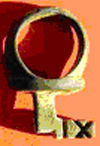The first keys
The Romans created the first keys in the modern sense. They replaced the clumsy “door keys” that had previously been used to slide heavy bolts back and forth on guides (staples).
 The keys to various Roman metal locks were usually made of bronze or iron, or a combination of the two. Bone and hard wood have also been used.
The keys to various Roman metal locks were usually made of bronze or iron, or a combination of the two. Bone and hard wood have also been used.
The keys to locks with pin tumblers were small and light with an easy-to-grasp bow. The shafts were very simple or were shaped like humans or animals. They had angular bits and sometimes holes in the shaft. A convenient innovation was the tiny key that was a part of a finger ring. These were used for small storage and jewelry boxes.
The Roman lock and key craft was an extremely high class and required a great deal of technical finesse and elegance. Some keys to turnkey locks had a shape like modern keys. Many of the wooden locks that were still in use were modernized with metal parts and keys.
Keys were primarily status symbols in the hands of those in society who had property to protect. The shafts of some keys also reflect something of the architecture of the day – not only fitting into solid locks of bronze or steel, but sometimes also resembling the door the lock was in or the gable of the house were the door was.
A large number of keys of various types from this era are on display in Saalburg, one of many Roman forts built along the border to the Germanic tribes. The keys, widely varied and adapted, were found with many parts of various types of locks. The Saalburg fort is now a museum, 30 km north of Frankfurt am Main in southwestern Germany.
The Hanns Schell Collection lock museum in Graz, Austria, also has a significant collection of keys and locks from the Roman Empire.